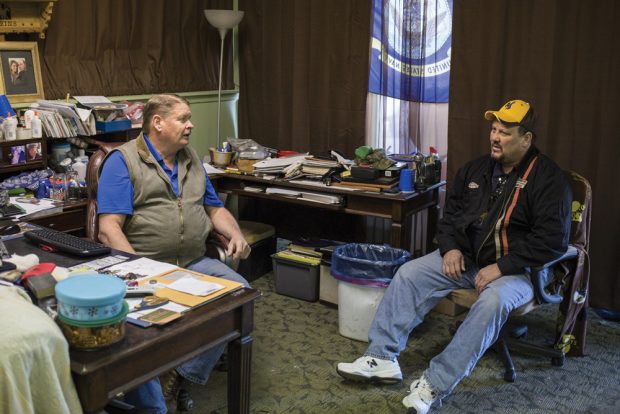
Mark Perkins, left, and Scott Pearce talk about recent layoffs from the nearby Black Thunder Coal Mine at Perkins’ electrical shop in Wright, Wyo., on April 5, 2016. Perkins is closing his business after the mine laid off hundreds of workers, including Pearce, due to a dramatic decline in demand for coal. The town, with a population of less than 2,000, relies heavily on the energy industry to sustain itself. As energy prices and demand for coal decline the state is struggling to support it’s ailing, energy-dependent economy.
By Joshua Zaffos/High Country News
Europe and the U.S. have taken different paths in response to climate concerns and coal declines.
People linger at an outdoor café, children run around a park, and visitors tour a former coal mine, now a thriving museum. The one-time industrial site, which includes an events center, restaurants, and even a Ferris wheel, attracted 1.5 million visitors over the past five years. Zollverein, Germany, once home to one of Europe’s largest coal mines, is now a retail and tourist destination.
The second act at Zollverein may provide inspiration — or aggravation — for down-and-out coal communities in Wyoming’s Powder River Basin and elsewhere in the West. March 31 has become known as Black Thursday in Wyoming since Arch Coal and Peabody Energy announced 465 layoffs at two major mines, amid recent Chapter 11 bankruptcy filings by Arch, Alpha Natural Resources and Peabody. Given the combination of crashing prices, bankruptcies, and a global push to phase out fossil fuels, the layoffs are likely just beginning.
In northeastern Wyoming, where coal provides one out of every 10 jobs and has generated billions of dollars for schools, roads and other public services, plans for a popular museum or conference center seem far-fetched. Good jobs are scarce outside the energy industry, and retirement benefits from faltering companies seem uncertain. Many locals wonder how their small towns will survive. Given all this, the official government response feels underwhelming.
While Zollverein is a long way from the Powder River Basin — the German mine is near a city of almost 600,000 people — U.S. economists and policy analysts are eyeing Europe, where governments, companies and unions are charting a different path toward life after coal. Overseas, coalfields are also facing job cuts, but unemployment benefits generally last longer, job training and economic-development programs are more extensive and retirement benefits better protected. “The safety net is much different in Europe,” says Robert Godby, a University of Wyoming economist.
As concern over climate change has grown, Europe and the U.S. have taken different paths. In the U.S., coal-producing states and Congress have balked at steps to shift from coal to other industries, while Europe has more willingly embraced the transition.
Germany, which relied heavily on coal for power and jobs following World War II through reunification, has the most productive lignite mines in the world. But the government is now scaling back soft-coal mining as part of a national effort to address climate change by reducing fossil fuel use and investing in renewables. Mining subsidies are being phased out by 2018, according to agreements negotiated by the German government and industry.
The arrangement has created a “soft landing” for workers and companies without unexpected mass layoffs or abrupt bankruptcies. Many older workers will ease into retirement, while younger miners can take advantage of Germany’s strong vocational training and apprenticeship programs to pursue work in engineering, technology and other industries.
The U.S., however, lacks a comprehensive climate action or energy policy. Miners and officials in Wyoming and elsewhere tend to blame President Obama and the Clean Power Plan, rather than global price drops, export declines and environmental pressures, for coal’s downfall. “First, it’s fiction,” says Adele Morris, a senior fellow with the Brookings Institution, who authored a recent report on the future of coal communities and workforces, “and, second, it’s unconscionable for leaders to not serve the people. It behooves us to do right by these folks who kept the lights on.”
Instead, while global forces buffet industry and workers, U.S. lawmakers have done little to ease their pain or adjust to new realities. Wyoming Gov. Matt Mead, R, opened temporary community resource centers in the coal towns of Casper, Gillette and Douglas to provide information on unemployment insurance, job opportunities and training, and counseling services. Following Black Thursday, more than 900 people showed up at the centers and workforce offices, including some unemployed oil and gas workers. But the state’s latest energy strategy is focused on fossil fuels with scarcely any mention of renewables, and Mead recently said Wyoming is “doubling down on coal,” aggressively backing unproven “clean coal” and carbon capture and storage technology, in hopes of somehow bucking the global downturn.
In Europe, stabilizing forces also include the unions. Germany’s mining, energy and chemical industry trade union is one of the nation’s strongest, and has helped maintain welfare and retirement benefits and pensions and supported the negotiated phase-outs of coal. In contrast, the once-mighty U.S. mining-labor -movement is in steep decline. The United Mine Workers had 800,000 members in the 1930s, but now represents just 35,000 active and 40,000 retired miners. A mere 5 percent of mining, quarrying, and oil and gas workers were members in 2014.
“In the Powder River Basin, union mining is almost nonexistent,” says Godby, partly since strip mines there have small workforces compared to West Virginia and Kentucky’s underground mines. The union has fought hard to prevent companies from trying to duck out of retirement benefits in Appalachia, but it has little stake or influence in the Powder River Basin. Arch Coal, at least, has said it will continue to make retiree benefit payments after filing for bankruptcy. But the company’s executives also paid themselves exorbitant bonuses despite the bankruptcy announcements. For laid-off workers, Arch is offering between four and 26 weeks of severance pay.
Behind decisions over unions, retirement and support services, notes Godby, is a larger debate over what citizens expect from governments. In Europe, governments and citizens have mostly supported broader public resources and a greater safety net than the U.S., where limited government remains a mantra among conservatives and even some progressives. On top of that, Europe’s politics are generally more left-leaning, with social-democratic influences that walk the line between capitalism and -socialism.
A stronger safety net, however, requires higher taxes, a trade-off most Americans resist. So while Wyoming miners average $83,000 a year, a laid-off worker collects perhaps $470 a week, and benefits can run out after half a year. In Germany, a lignite miner’s salary was roughly $57,000, in 2011, and tax rates are about double U.S. rates, but unemployment benefits pay job seekers two-thirds of their former earnings for up to two years, and healthcare continues despite job loss.
In remote Svalbard, Norway, small coal-mining communities are surviving thanks to government help. Payments of about $66 million helped the state-owned mining company, Store Norske, concentrate operations in one expanded mineshaft while closing down others, giving the community time to develop alternative industries. The company and government also formed a local tourism enterprise and helped develop a university Arctic research program.
In the U.S., President Obama launched the POWER Initiative last year to provide about the same amount, $65.8 million, for job training, job creation and economic diversification for slumping coal communities. But it’s mostly focused on Appalachia, and isn’t big enough, considering the size of the country’s energy industry. According to the recent Brookings report, protecting retiree benefits, reclaiming abandoned mines and providing substantive job training would require tens of billions of dollars.
To generate that sort of money, Morris suggests that a carbon tax — anathema to energy-dependent states and many politicians — could actually help by providing predictable coal-price changes for companies and collecting funds that could be set aside to help communities and workers.
“Regardless of regulation, the market and outlook for coal is grim, and it’s unfair and unwise to rely on a rebound,” Morris says. “It’s going to take a lot of money, and our (national and state) budgets are wholly unsuited to the kind of ambition we need to help revitalize these areas. But it’s much easier said than done.”
This story originally appeared in the May 16, 2016 issue of High Country News (hcn.org).






Be the first to comment on "What the U.S. can learn from European coal miners’ second act"